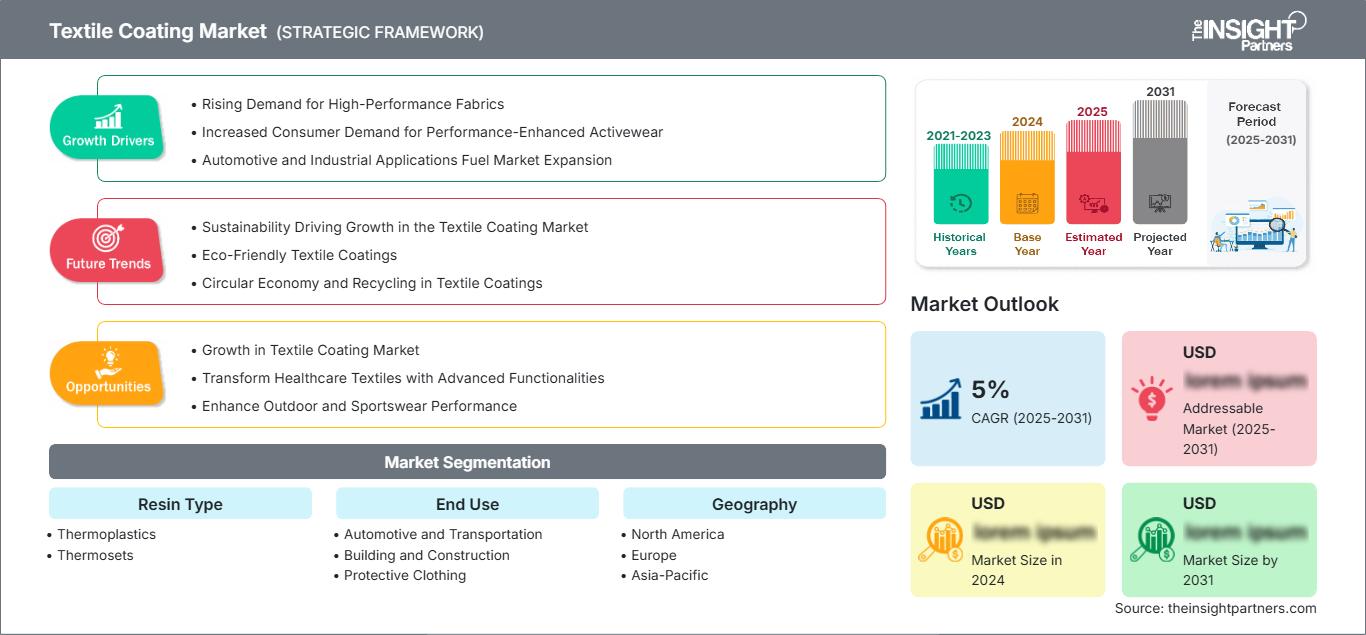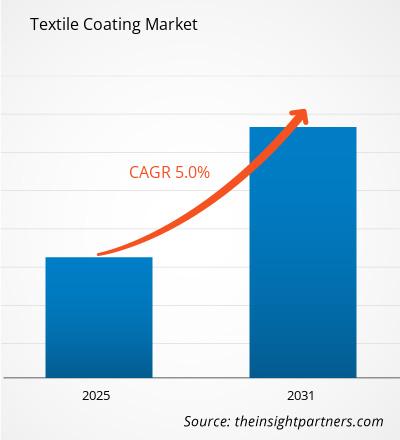Se prevé que el mercado de recubrimientos textiles registre una tasa de crecimiento anual compuesta (TCAC) del 5% entre 2025 y 2031, con un tamaño de mercado que se expandirá de XX millones de dólares estadounidenses en 2024 a XX millones de dólares estadounidenses en 2031.
El informe presenta un análisis basado en el tipo de resina (termoplásticos, termoestables y otros). Se segmenta por uso final (automoción y transporte, construcción, ropa de protección, sector médico, deportes y otros). El análisis global se desglosa a nivel regional y por países principales. El alcance del informe abarca el tamaño del mercado y las previsiones a nivel global, regional y nacional para todos los segmentos clave. El informe ofrece el valor en USD para el análisis y los segmentos mencionados. Además, proporciona estadísticas clave sobre la situación del mercado de los principales actores y presenta las tendencias y oportunidades del mercado.
Finalidad del informe
El informe sobre el mercado de recubrimientos textiles de The Insight Partners tiene como objetivo describir el panorama actual y el crecimiento futuro, los principales factores impulsores, los desafíos y las oportunidades. Esto proporcionará información valiosa a diversos actores del sector, tales como:
- Proveedores/fabricantes de tecnología: Para comprender la evolución de la dinámica del mercado y conocer las posibles oportunidades de crecimiento, lo que les permitirá tomar decisiones estratégicas informadas.
- Inversores: Realizar un análisis exhaustivo de las tendencias relativas a la tasa de crecimiento del mercado, las proyecciones financieras del mercado y las oportunidades que existen a lo largo de la cadena de valor.
- Organismos reguladores: Regular las políticas y controlar las actividades en el mercado con el objetivo de minimizar los abusos, preservar la confianza de los inversores y mantener la integridad y la estabilidad del mercado.
Segmentación del mercado de recubrimientos textiles
Tipo de resina
- Termoplásticos
- Termoestables
Uso final
- Automoción y transporte
- Construcción y edificación
- Ropa de protección
- Médico
- Deportes
Obtendrá personalización gratuita de cualquier informe, incluyendo partes de este informe, análisis a nivel de país y paquetes de datos de Excel. Además, podrá aprovechar excelentes ofertas y descuentos para empresas emergentes y universidades.
Mercado de recubrimientos textiles: Perspectivas estratégicas

-
Obtenga las principales tendencias clave del mercado que se describen en este informe.Esta muestra GRATUITA incluirá análisis de datos, que abarcarán desde tendencias de mercado hasta estimaciones y pronósticos.
Factores que impulsan el crecimiento del mercado de recubrimientos textiles
- Aumento de la demanda de tejidos de alto rendimiento: El aumento de la demanda de tejidos de alto rendimiento impulsa el crecimiento del mercado de recubrimientos textiles. Los tejidos de alto rendimiento utilizados en ropa deportiva, automoción y aplicaciones médicas requieren recubrimientos especiales para mejorar su durabilidad, resistencia al agua, protección UV y resistencia al fuego. Con la mayor demanda de este tipo de textiles, surge una necesidad correspondiente de recubrimientos textiles.
- Mayor demanda de ropa deportiva de alto rendimiento: Los consumidores de ropa deportiva y para actividades al aire libre buscan tejidos que ofrezcan un mejor rendimiento en entornos exigentes. Los recubrimientos textiles proporcionan estas propiedades, como transpirabilidad, absorción de la humedad y aislamiento térmico. Por lo tanto, la creciente demanda de ropa deportiva de alto rendimiento aumenta las perspectivas del mercado de recubrimientos textiles. Los fabricantes de este tipo de prendas buscan soluciones de recubrimiento superiores.
- Expansión del mercado de aplicaciones automotrices e industriales: El uso de textiles de alto rendimiento en asientos de automóviles, bolsas de aire y equipos de protección está cobrando mayor relevancia en las industrias automotriz e industrial. Estos productos requieren recubrimientos para mejorar sus características de rendimiento, como la resistencia al desgaste, a los productos químicos y al calor. La demanda de recubrimientos textiles especializados, desarrollados para mejorar la seguridad del producto y prolongar su vida útil, contribuye al crecimiento del mercado.
Tendencias futuras del mercado de recubrimientos textiles
- La sostenibilidad impulsa el crecimiento del mercado de recubrimientos textiles: Las soluciones sostenibles y ecológicas se están consolidando como importantes motores de crecimiento para el futuro del mercado de recubrimientos textiles. A medida que aumenta la concienciación y la preocupación por el medio ambiente tanto entre los consumidores como entre las industrias, crece la demanda de recubrimientos libres de sustancias químicas nocivas y con menor impacto ambiental. Esta tendencia fomenta la innovación e impulsa a los fabricantes a adoptar alternativas sostenibles.
- Recubrimientos textiles ecológicos: Las formulaciones biodegradables a base de agua son un ejemplo de recubrimientos textiles ecológicos que han ganado popularidad recientemente debido a que reducen la toxicidad y el impacto ambiental en la fabricación de textiles. Además de ser más respetuosos con el medio ambiente, los recubrimientos que cumplen con las normativas ambientales más estrictas resultan atractivos para los fabricantes que buscan alcanzar sus objetivos de sostenibilidad.
- Economía circular y reciclaje en recubrimientos textiles: Otro factor clave para la demanda de recubrimientos es el creciente interés en las prácticas de economía circular en la industria textil. Esto exige recubrimientos que permitan el reciclaje y la reutilización sin obstaculizar el proceso de reciclaje ni la reutilización de los tejidos. De esta forma, se alinean con los objetivos generales de reducir los residuos y crear productos sostenibles a lo largo de todas las etapas del ciclo de vida del producto en la industria textil.
Oportunidades de mercado en el recubrimiento textil
- Crecimiento del mercado de recubrimientos textiles: Los recubrimientos inteligentes para aplicaciones textiles funcionales están generando un enorme potencial de crecimiento en el mercado de recubrimientos textiles. Los tejidos funcionales pueden preacondicionarse para responder a estímulos externos como la temperatura, la humedad o la luz al aplicarse estos recubrimientos inteligentes. A medida que aumenta la demanda de textiles innovadores y de alta tecnología, los recubrimientos inteligentes adquieren una importancia creciente para aplicaciones en prendas inteligentes, el sector sanitario y la ropa deportiva.
- Transformación de los textiles sanitarios con funcionalidades avanzadas: En el sector sanitario, los recubrimientos inteligentes permiten crear prendas con propiedades antimicrobianas o de biosensores, lo que mejora la atención y la seguridad de los pacientes. Por ejemplo, ante la creciente preferencia por la ropa médica con recubrimientos que monitorizan la temperatura corporal o la sudoración, los textiles médicos se enfrentan ahora a una mayor demanda de recubrimientos avanzados que puedan soportar estas funcionalidades.
- Mejora del rendimiento de la ropa deportiva y para actividades al aire libre: Los recubrimientos inteligentes para ropa deportiva mejoran el rendimiento de las prendas, tanto para actividades al aire libre como para deportes o moda. En la industria de la moda, se requieren recubrimientos que hagan que los tejidos sean resistentes al agua, a los rayos UV o autolimpiables. A medida que crecen los mercados de ropa deportiva y para actividades al aire libre, las oportunidades que ofrecen los recubrimientos técnicos para mejorar la durabilidad y la comodidad en la producción de prendas crean nuevas áreas para la innovación en recubrimientos textiles y la expansión del mercado.
Perspectivas regionales del mercado de recubrimientos textiles
Los analistas de The Insight Partners han explicado en detalle las tendencias y los factores regionales que influyen en el mercado de recubrimientos textiles durante el período de previsión. Esta sección también analiza los segmentos y la geografía del mercado de recubrimientos textiles en Norteamérica, Europa, Asia Pacífico, Oriente Medio y África, y Sudamérica y Centroamérica.
Alcance del informe de mercado de recubrimientos textiles
| Atributo del informe | Detalles |
|---|---|
| Tamaño del mercado en 2024 | XX millones de dólares estadounidenses |
| Tamaño del mercado para 2031 | XX millones de dólares estadounidenses |
| Tasa de crecimiento anual compuesto global (2025 - 2031) | 5% |
| Datos históricos | 2021-2023 |
| período de previsión | 2025-2031 |
| Segmentos cubiertos |
Por tipo de resina
|
| Regiones y países cubiertos |
América del norte
|
| Líderes del mercado y perfiles de empresas clave |
|
Densidad de los actores del mercado de recubrimientos textiles: comprensión de su impacto en la dinámica empresarial
El mercado de recubrimientos textiles está creciendo rápidamente, impulsado por la creciente demanda de los usuarios finales debido a factores como la evolución de las preferencias de los consumidores, los avances tecnológicos y una mayor conciencia de los beneficios del producto. A medida que aumenta la demanda, las empresas amplían su oferta, innovan para satisfacer las necesidades de los consumidores y aprovechan las nuevas tendencias, lo que impulsa aún más el crecimiento del mercado.

- Obtenga una visión general de los principales actores del mercado de recubrimientos textiles.
Puntos clave de venta
- Cobertura integral: El informe abarca de forma exhaustiva el análisis de productos, servicios, tipos y usuarios finales del mercado de recubrimientos textiles, proporcionando una visión holística.
- Análisis de expertos: El informe se elabora a partir del profundo conocimiento de expertos y analistas del sector.
- Información actualizada: El informe garantiza su relevancia para el negocio gracias a su cobertura de información reciente y tendencias de datos.
- Opciones de personalización: Este informe se puede personalizar para satisfacer las necesidades específicas del cliente y adaptarse adecuadamente a las estrategias comerciales.
Por lo tanto, el informe de investigación sobre el mercado de recubrimientos textiles puede ayudar a liderar el proceso de análisis y comprensión del panorama de la industria y sus perspectivas de crecimiento. Si bien existen algunas preocupaciones válidas, los beneficios generales de este informe tienden a superar las desventajas.
- Análisis histórico (2 años), año base, pronóstico (7 años) con CAGR
- Análisis PEST y FODA
- Tamaño del mercado, valor/volumen: global, regional y nacional
- Industria y panorama competitivo
- Conjunto de datos de Excel
Informes recientes
Informes relacionados
Testimonios
Razón para comprar
- Toma de decisiones informada
- Comprensión de la dinámica del mercado
- Análisis competitivo
- Información sobre clientes
- Pronósticos del mercado
- Mitigación de riesgos
- Planificación estratégica
- Justificación de la inversión
- Identificación de mercados emergentes
- Mejora de las estrategias de marketing
- Impulso de la eficiencia operativa
- Alineación con las tendencias regulatorias






















 Obtenga una muestra gratuita para - Mercado de recubrimientos textiles
Obtenga una muestra gratuita para - Mercado de recubrimientos textiles